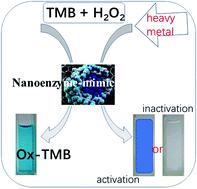Our official English website, www.x-mol.net, welcomes your
feedback! (Note: you will need to create a separate account there.)
Recent developments of nanoenzyme-based colorimetric sensors for heavy metal detection and the interaction mechanism.
Analyst ( IF 3.6 ) Pub Date : 2020-03-29 , DOI: 10.1039/d0an00339e Zhengquan Yan 1 , Hua Yuan , Qi Zhao , Lin Xing , Xiaoyu Zheng , Weiguo Wang , Yulei Zhao , Yang Yu , Lei Hu , Wenli Yao
Analyst ( IF 3.6 ) Pub Date : 2020-03-29 , DOI: 10.1039/d0an00339e Zhengquan Yan 1 , Hua Yuan , Qi Zhao , Lin Xing , Xiaoyu Zheng , Weiguo Wang , Yulei Zhao , Yang Yu , Lei Hu , Wenli Yao
Affiliation

|
Heavy metal contamination has posed a great threat to human survival and social development. For this, a series of nanoenzyme-based colorimetric sensors, e.g., metal nanoparticles, metal oxides, metal sulfides, graphene-based nanomaterials, G-quadruplex and so on, were developed for the rapid and efficient detection of toxic heavy metal ions, whose detection limit for heavy metal ions could be as low as the nmol L-1 level. The recognition mechanism was based on the catalysis and signal amplification of nanozymes, a new type of nanomaterial possessing specific catalytic activity towards certain chemical reactions such as the oxidation of colorless TMB to blue oxTMB. In this work, we are trying to present readers with a better understanding of this important colorimetric sensing material by illustrating its application in the detection of heavy metal ions using metal nanoparticles, metal oxides, metal sulfides, graphene-based nanomaterials, G-quadruplex, etc. respectively.
中文翻译:

基于纳米酶的比色传感器用于重金属检测及其相互作用机理的最新进展。
重金属污染对人类的生存和社会发展构成了巨大威胁。为此,开发了一系列基于纳米酶的比色传感器,例如金属纳米颗粒,金属氧化物,金属硫化物,石墨烯基纳米材料,G-四链体等,用于快速有效地检测有毒重金属离子。重金属离子的检出限可能低至nmol L-1水平。识别机制基于纳米酶的催化和信号放大,纳米酶是一种新型的纳米材料,对某些化学反应具有特定的催化活性,例如将无色TMB氧化为blue oxTMB。在这项工作中
更新日期:2020-03-13
中文翻译:

基于纳米酶的比色传感器用于重金属检测及其相互作用机理的最新进展。
重金属污染对人类的生存和社会发展构成了巨大威胁。为此,开发了一系列基于纳米酶的比色传感器,例如金属纳米颗粒,金属氧化物,金属硫化物,石墨烯基纳米材料,G-四链体等,用于快速有效地检测有毒重金属离子。重金属离子的检出限可能低至nmol L-1水平。识别机制基于纳米酶的催化和信号放大,纳米酶是一种新型的纳米材料,对某些化学反应具有特定的催化活性,例如将无色TMB氧化为blue oxTMB。在这项工作中











































 京公网安备 11010802027423号
京公网安备 11010802027423号